Colorful Benches Tell Story of Stormwater Management
High school art interns created 10 community benches illustrating unique Milwaukee story.
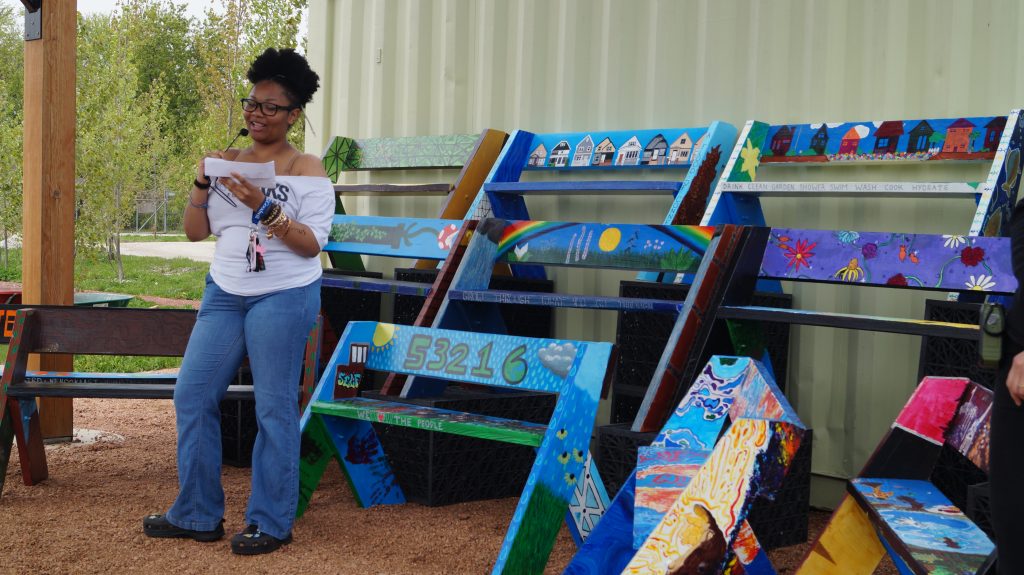
Jay Berry-McIntyre shares the story of her bench, “Native Plants,” at Green Tech Station on May 4, 2024. Photo by Michael Timm.
They are benches to sit on. But also art works. And for good measure they impart a kind of ecological message.
The benches are being painted by students, ArtWorks for Milwaukee interns, and will ultimately be featured — and sat on — at the Green Tech Station, a green infrastructure research and demonstration site near 31st Street and Capitol Drive. Green Tech Station is a former-brownfield that now hosts outdoor tours to showcase different practices that help manage stormwater. And these benches will help tell — and illustrate — that story.
Throughout 2024, 10 high school interns planned and painted their own artwork on these benches, working under the supervision of the nonprofit Artworks as paid environmental arts interns. Artworks has focused on community water projects in the 30th Street Corridor for years.
While the goal is to tell the story of stormwater management, “we got a lot of creative liberty with this,” said DeAnthony Roaf, who attends Golda Meir High School. On his bench, “Mario’s Pipe Dream,” Roaf featured green pipes from the popular Super Mario Brothers video games. He even hid a little Mario for people to find. “The idea came when we took a field trip to Green Tech Station where I could see how simple systems like pipes are able to do so much to help our community,” Roaf said.
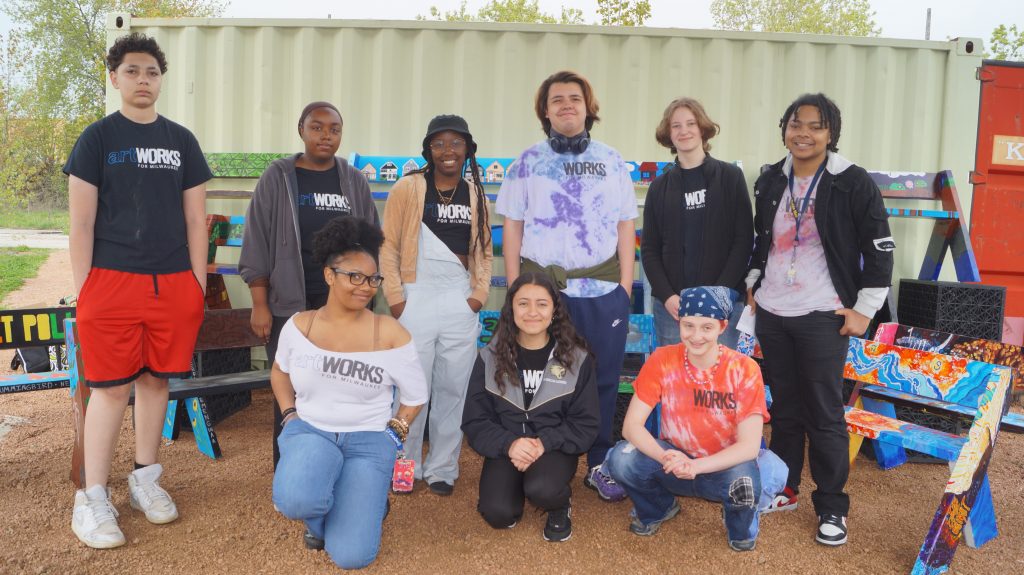
Back row, left to right: Noah Calvin, Kayla Teague, Shamauri Harrington, Marco Vallejo, Rachel Lebeck, and DeAnthony Roaf. Front row, left to right: Jay Berry-McIntyre, Adriana Rios, and Ali Benjamin. Photo by Michael Timm.
Milwaukee High School of the Arts student Marco Vallejo’s bench is titled “Under the Surface.” The design reflects the path of water through green infrastructure like the bioswales the interns learned about during their tour. Bioswales are vegetated ditches engineered to manage water. “You have plants, you have a little tree growing, and you also have a pond, and you can see the water’s going down to this part of the bench,” explained Vallejo.
Jay Berry-McIntyre, who attends Whitefish Bay High School, titled her work “Native Plants.” She wanted her design to be colorful and bold. “I wanted it to be like what we use water for and why we should be thankful for water and why we should protect it,” Berry-McIntyre said. Bench panels show scenes of washing, showering, drinking, and watering plants. “And on the backside of the bench, it’s the big G from Green Tech Station.”
The “big G” is also art-related. It’s a WaterMarker, a 30-foot-tall, solar-powered illuminated letter that pulses when the Milwaukee Metropolitan Sewerage District (MMSD) issues a Water Drop Alert to advise residents to limit water use in event of heavy rains that could overwhelm the sewer system. As of 2024, there are four WaterMarkers installed across the city, with plans for at least six more.
Each WaterMarker, whose letter is selected to represent community themes — G stands for gritty, gather, growth, and the Garden Homes neighborhood — is also associated with local art project supported by the citywide WaterMarks initiative. At Green Tech Station, artist Glenn Williams created two sculptural pieces inspired by African water vessels that flank the south walking path. They contain proverbs: “Water has no enemies” and “Water is an ancestor.”
WaterMarker letters worked their way into bench designs.
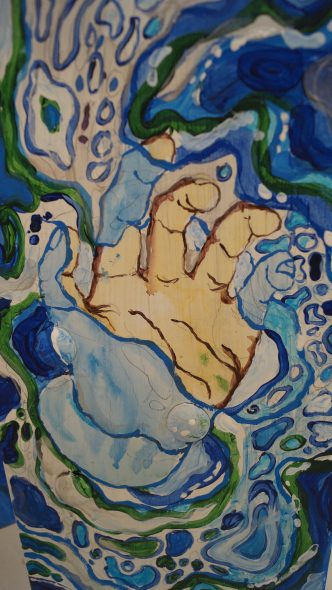
Close-up of the side panel of Ali Benjamin’s painted bench, “From a Trickle to a Roar.” Photo by Michael Timm.
A swirling explosion of warm colors encircles the fiery letters A, Ñ, G, and H — the WaterMarker installations so far — on “From a Trickle to a Roar,” the bench designed by Pius XI student Ali Benjamin. “The WaterMarkers are a light source, so the red and yellow and orange represent that light source,” said Benjamin. “And then I wanted an element that brings in the people. So, I put the hands on either side. One of them has the light source and the other has running water.”
The kaleidoscope of artistic perspectives afforded by painting simple places to sit tells a story of community, of how to value all people and forms of life.
Rachel Lebeck, who attends Nathan Hale High School, painted vibrant butterflies and ruby-throated hummingbirds in her design, “Protect Pollinators,” which also features the species’ names in Ojibwe and Potawatomi. “I figured that with the native plants and native pollinators, I might as well throw in the native languages of the people who lived here before us,” Lebeck said.
Interns felt an intimate connection to water — and the existential need to protect it.
“Water is in everything we do. The way we eat. The way we drink. It’s in us. We use it every day,” said Shamauri Harrington, who attends Golda Meir High School and called her bench “Water-based Relations.” Her art shows a neighborhood with a flower-filled basin at its heart. On the back she included a fluid invocation: “Help water, help us.”
Water relations are not always positive. As part of their preparation, the interns learned how the 2008 and 2010 storms in this metro area led to widespread flooding throughout Milwaukee’s 30th Street Corridor. Addressing flood risk motivated MMSD to construct city-block sized, vegetated stormwater basins in the Garden Homes neighborhood north and east of Green Tech Station.
In her bench, “A Flood of Connection,” Adriana Rios, who attends Franklin High School, drew inspiration from this story. She painted a variety of Milwaukee homes rising above a field of blue. Rios, whose own family experienced a flooded basement, wanted to emphasize that people came together in response to the flooding. “Why not bring in the positive aspect of how [basins and bioswales] help decrease the amount of flooding and also bring the community together through recreational opportunities?” Rios said.
“Neighborhood Resilience” is bench title of Kayla Teague, who attends Pius XI High School — though her design came to focus on one tool in the green infrastructure toolkit. The seat says “AQUABLOX,” the trade name for a plastic-crate-like module used to manage stormwater flooding.
When these hollow blocks are stacked together underground and enclosed, their empty space is used to contain water, while their lightweight gridded structure supports the weight of the ground above. Green Tech Station’s plaza overlies one such cistern built of blocks and is able to hold 20,000 gallons of water collected from four bioswales. That water can be pumped up for irrigating over 400 trees planted on site or slow-released — rather than flooded — into the sewer system.
Teague’s design drew inspiration from the gridded pattern of individual blocks, each about the size of a large cooler, on display to help explain the system hidden below.
For some interns, creating art was less technical and more deeply personal — providing healing and solace.
Noah Calvin, who attends Alliance High School, titled his bench “Season Change.” All four seasons are shown. “There’s parts of my life — it’s broken,” Calvin said. “It can’t be fixed.” His winter scene shows cracks in ice symbolizing this brokenness, but Calvin also painted an autumnal “Love Tree” symbolizing good memories with family. Jagged summer lightning signifies the sudden power of things we cannot control but alter our lives. On the back he painted the metamorphosis of caterpillar into butterfly.
Ability Kostecki’s design featured rainbows surrounding sun and moon. “I feel like it’s just very inspiring and brings a sense of joy to be able to see the simple things in nature,” said Kostecki of her bench, “Simple Significance.” She graduated from Barack Obama School of Career and Technical Education, works as a cook, and looks forward to studying environmental engineering at UW-Milwaukee.
Interns benefited from mentors just a few years older.
“I learned a lot about just how far kids this age can go if you give them even a little bit of encouragement. They’re extremely talented,” said Sydney Eserkaln, one of three lead artist assistants ArtWorks employed to support the interns, who watched them grow into “very professional people.”
Eserkaln teamed with Lily Gruenewald and Mitchell Liebhauser on the mentors’ own bench, “Unearthed,” depicting subterranean critters, fossils, invertebrates, and pathways hidden underground.
Lead artist Marco Romantini led ArtWorks’ environmental arts internship, and Tracy LoMenzo managed the program. The bench project was in partnership with the nonprofits Northwest Side Community Development Corporation, which manages Green Tech Station, and Reflo, which built the benches and supports the site.
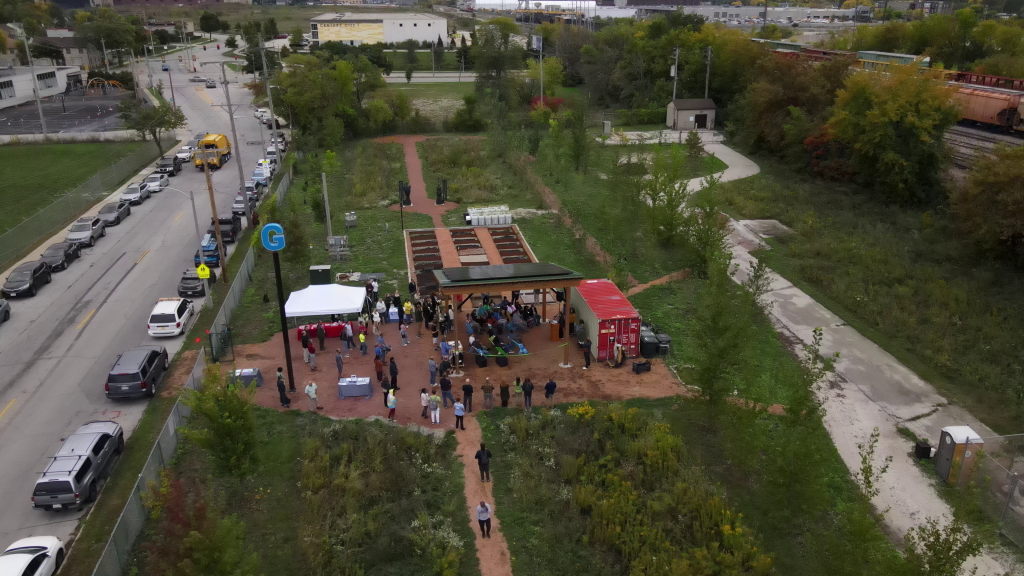
Aerial view of Green Tech Station in 2023. WCMP did not fund the drone photography. Photo courtesy of Reflo.
The benches were unveiled on May 4, followed by a volunteer workday pulling weeds, spreading woodchips, and hauling gravel. Proud parents and partners witnessed the results of months of hard work.
The interns also created custom murals surrounding storm drains at nearby Samuel Clemens School to remind the public that these carry water to our rivers and Lake Michigan.
WaterMarks art by Mikal Floyd-Pruitt — along with a new “big C” WaterMarker for community, Century City, connections, clean, and collaboration — is planned for nearby Melvina Park, a city park being expanded with green infrastructure. Another WaterMarker and art are also planned for MMSD’s West Basin stormwater management project on the former Bee Bus Line site.
Green Tech Station is open for tours by appointment through the Northwest Side Community Development Corporation’s website.
Photos by Michael Timm
Photos by Michael Timm
Writer Michael Timm, a Milwaukee Water Storyteller for the nonprofit Reflo, did our earlier series on reintroducing the sturgeon into the Milwaukee River.
This project is funded by the Wisconsin Department of Administration, Wisconsin Coastal Management Program and the National Oceanic and Atmospheric Administration under the terms and conditions of Wisconsin Coastal Management Program Grant Agreement No. AD239125-024.21. Funded by the Wisconsin Coastal Management Program and the National Oceanic and Atmospheric Administration, Office for Coastal Management under the Coastal Zone Management Act, Grant # NA22NOS4190085

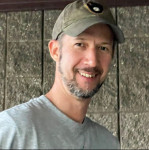
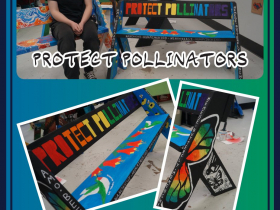
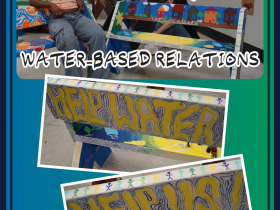
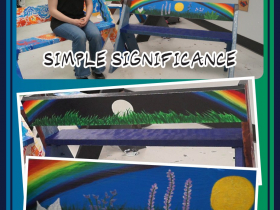
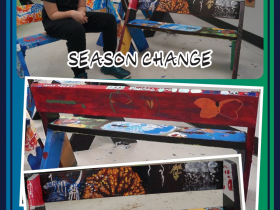
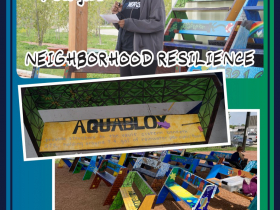
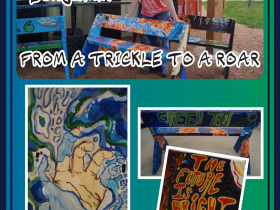
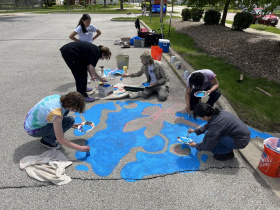
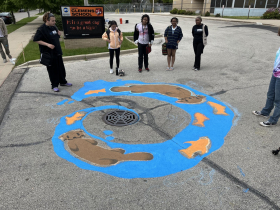
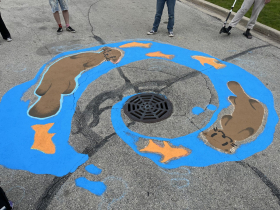
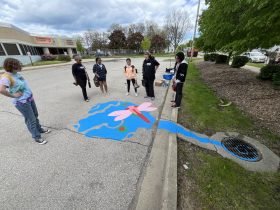
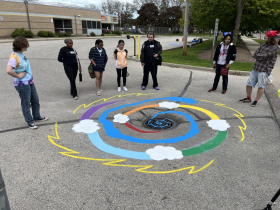




















This is so wonderful…KUDOS!!!!